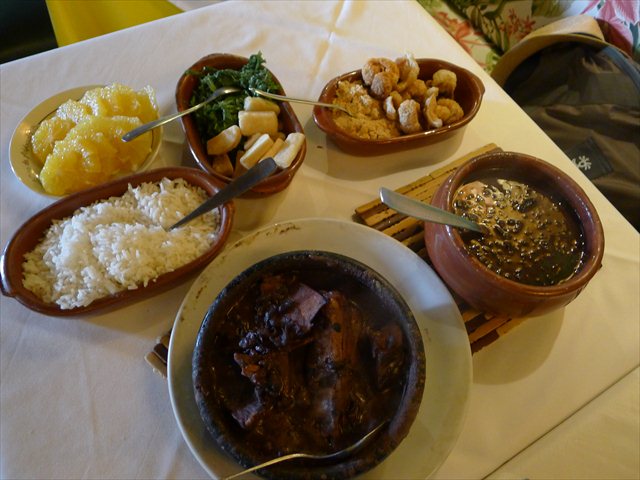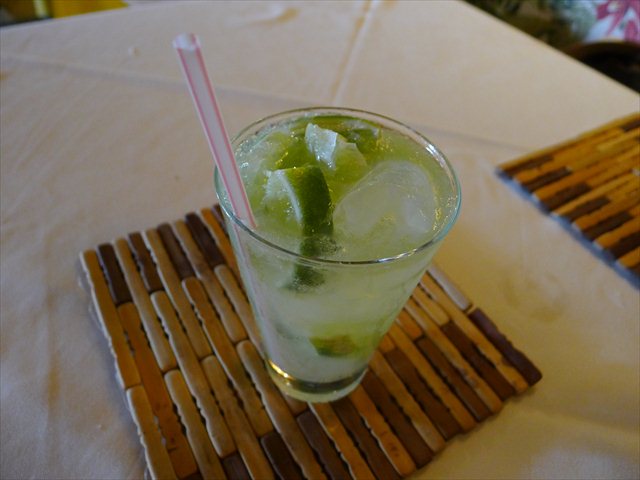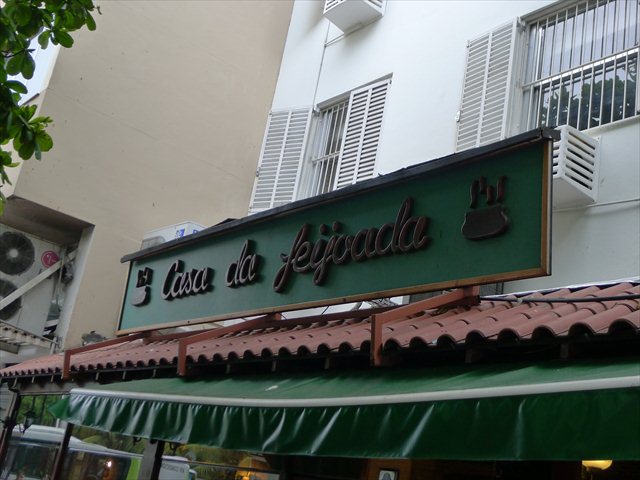There are a few other things which find themselves onto a to-do-list for a visit to Rio.
1) Christ the Redeemer
2) The cable car up to Sugarloaf
3) Sunning yourself on Ipanema
4) Eating your body weight in meat at one of the churrascarias the city is famed for.
5) Drinking a few caipirinhas
6) Tasting feijoada. It appears as a heady concoction of meat. And beans. With slices of sunshine-orange. Those seem to be the key ingredients, and you can’t really cap off a visit to Rio without sampling some of it.
The sticky thing is that the first three things on that list are largely weather dependant. Yet when you find yourself in the city and the view of Christo looks like this;
and you can’t see much further than two metres in front of your face, you’ll do well follow the well publicised tourist advice (repeated here from one who didn’t listen) and don’t make the effort to go up to say hi to Christo up close. You certainly won’t be able to see much more once you’re up there (and the backlogged queue to descend on a train can take up to two hours, which when you’re sitting out in the rain and the fog, is about as much fun as it sounds).
So when you wake up to see Ipanema looking like this;
 there’s also less fun to be had sipping coconuts and shopping from the mobile bikini stores that traipse across the sands.
there’s also less fun to be had sipping coconuts and shopping from the mobile bikini stores that traipse across the sands.
So what’s left is to go eat. Luckily, Rio is a good city for that.
Feijoada is a Brazilian dish traditionally eaten on Saturdays, in large festive gatherings. Yet if you haven’t got an instant family to latch on to, then there’s always Casa da Feijoada.
It’s a cosy spot on a leafy corner of Ipanema (which is much more hospitable than the neighbouring Copacabana) . The feijoada menu will set you back around 78 soles per person. It’s more food than you could possibly dream of.

It starts with a bowl of caldo de feijao, a sturdy, midnight dark bean soup in sturdy earthenware bowls.
From there you get to choose your meat. Feijoadas origins are in the darker corners of Brazil’s past. It was a dish born of poverty and enslavement as a way to make good from the parts of a beast that those who sat on high tossed away.
It’s traditionally made with snout, hoof and sausage.
At Casa da Feijoada you can choose your elements; it can be made up of cured pork, dried, pork, snout, sausage or loin. Pick the adventurous bits, or a more cautious path; it’s up to you. It will come with white rice, soft black beans, sautéed greens, toasted manioc flour- which has a grit like soft sand, pork scratchings and orange slices. There will also be a shallow dish of pimenta, a combination of oil soused peppers, which pack an aggressively hot punch.
It would be a little wrong not to have a caipirinhas to go with it. This is sturdy food, ideally suited to a grey day. And considering the portion sizes, it’s a grand thing to indulge in you don’t have plans to go buy a new bikini at the end of it all.
Nb, feijoada is also a terrific meal to make at home for a crowd, or if you’re keen on living like a local with the comforts of a kitchen while you’re in Rio, there are plenty of options on Rio Vacation Rentals.
For a great recipe which we made last year, see here.

Casa de Feijoada
Rua Prudente de Moraes 10, Ipanema, Rio de Janeiro
Other Rio hints and tips
We found Ipanema felt safer and cleaner than Copacabana. We had originally booked to stay in Copacabana and I’m pleased that we swapped ahead of time.
Rio was one of those cities where we were more comfortable having a pre arranged transfer from the airport to the hotel for when we arrived. We used Rio Airport Transfers and found them to be efficient.
Accommodation in Rio can be hair raisingly expensive compared to other cities around the world. We stayed in the Everest Rio, a block and a half back from Ipanema beach. The location was good, the room fine, but watch out- it can take up to 30 minutes to check out (service not being the swiftest)- which can be tricky if you’re dashing to the airport.





